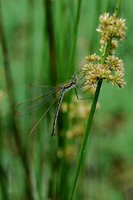More on the Bushfires of Victoria, and Tasmania.
http://www.theage.com.au/news/national/fears-rise-as-bushfires-merge/2006/12/12/1165685649353.htmlPhoto: Chris Hocking
That link will take you to the most recent report in "The Age". It reports on fires in the Mt Beauty area, one of the ski fields in the Victorian Alps, and also about fire having apparently destroyed "Cresta Lodge", one of several lodges in the Mt Buffalo National Park.
But the report also talks about a 40 Km fire control line, in the vicinity of Erica.
 Erica
Erica is in the northern section of Gippsland. It is rainforest country, on rich red volcanic soil, just like Robertson. I know because a fellow Peony enthusiast moved there about the same time as I moved to Robertson. He has had two fires threaten his place since he moved there. The difference is that the Victorian high country is dominated by tall Eucalypt forest, and we all know how that can burn ferociously, in a bad year. This is a bad year!
*****
Tasmania, mainly on the north-east coast is suffering. Last night up to 18 houses
near Scamander were destroyed, apparently. That link will take you to the ABC news website report.
It seems odd that after the lead up to these fires being so well publicised in Victoria, that more damage has occured in Tasmania. Was the
Lennon Government asleep at the wheel? I wonder. In fairness to them, this report, from the
Tasmanian Fire Service does mention 100Km per hour winds. That makes any fire, especially in heavily timbered country impossible to deal with.
*****
One of the captions on the ABC Website, referrring to "Bushfire Summer" (apparently a forthcoming TV program) says:
"We have this incredible view of humans dominating Nature - and we ought to disabuse ourselves of that notion."
*****
An Update:
This link to
"The Age" updates you on the latest about the fires.
It also gives you a scary statistic of the area which fires have destroyed in Victoria, over the last 10 days.
250,000 hectares.
For those of you not good on imagining a large number of hectares, try:
2,500 Sq Kilometres, or 25 Km wide, by 100 Km long.
That is the distance from Robertson to Goulburn (one hour's drive on the freeway), and a width from the highway to the escarpment edge, near Bundanoon. It is an area larger than the Southern Highlands, by my reckoning. (Of course, it has not been a single burn, but patches of fire, but that's what it amounts to.)
Imagine if the entire Wingecarribee Region were to have been burnt.
*****
For the pre-metrics amongst you, try:
965 Sq Miles, which is 20 miles by 48 miles.
 The SCA has lodged a submission to the Federal Department of Environment and Heritage, as required under the Environment Protection and Biodiversity Conservation Act 1999 (EPBC Act). Put simply, the submission is a white wash (I am tempted to call it a "tissue of lies").
The SCA has lodged a submission to the Federal Department of Environment and Heritage, as required under the Environment Protection and Biodiversity Conservation Act 1999 (EPBC Act). Put simply, the submission is a white wash (I am tempted to call it a "tissue of lies"). They basically say that they are not going to harm the environment of the Kangaloon Aquifer - trust them - they know what they are doing.
They basically say that they are not going to harm the environment of the Kangaloon Aquifer - trust them - they know what they are doing. That bore site 2C is less than 100 metres from Butler's Swamp (left) - on Tourist Road. It is an "Endangered Ecological Community", listed under the EPBC Act.
That bore site 2C is less than 100 metres from Butler's Swamp (left) - on Tourist Road. It is an "Endangered Ecological Community", listed under the EPBC Act.















































